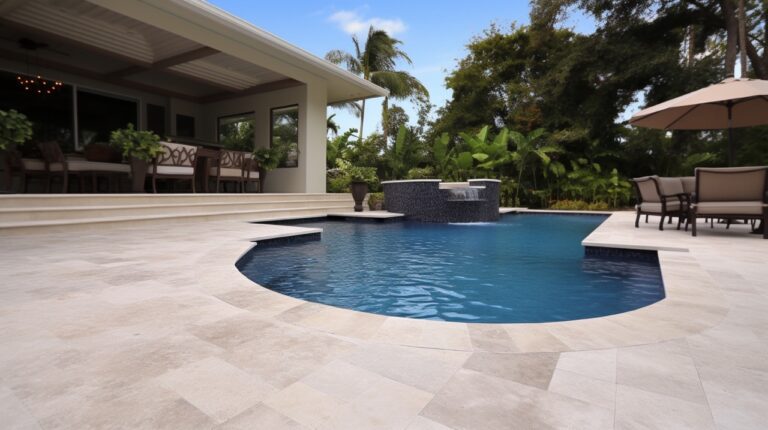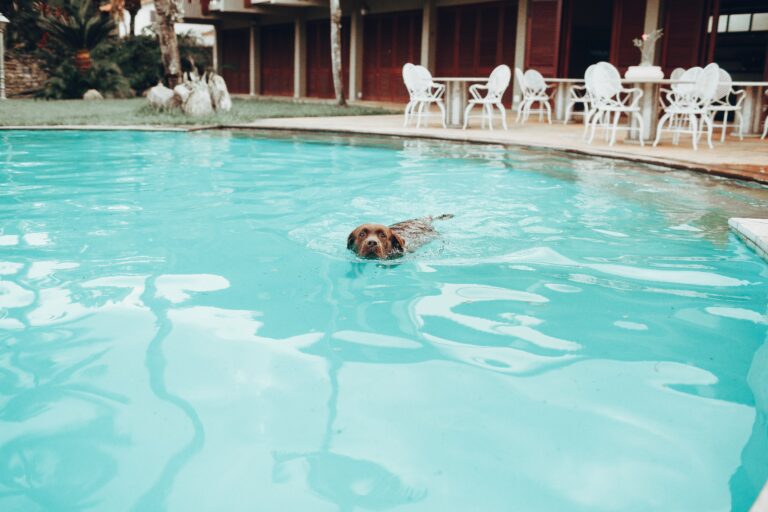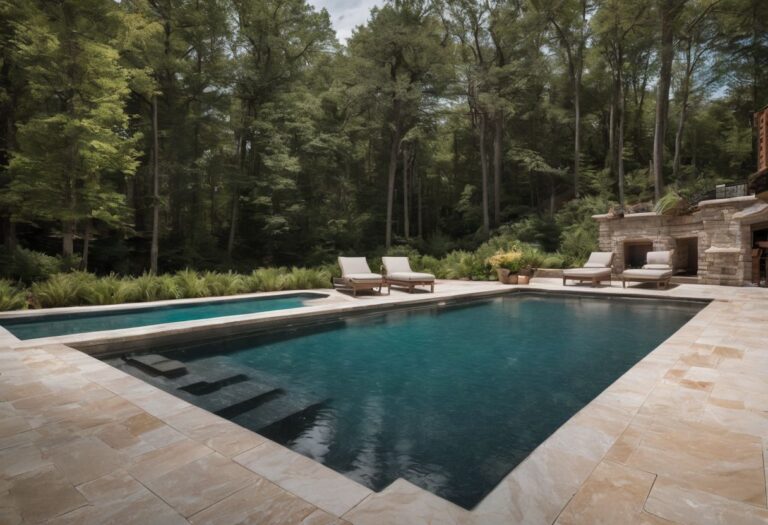How To Waterproof A Cinder Block Pool: 2023 Guide
How To Waterproof A Cinder Block Pool: Dive into our expert guide on waterproofing your cinder block pool. No more leaks or damages, only endless summer fun!”
How To Waterproof A Cinder Block Pool
You’ve dedicated your resources and energy to your cinder block pool – so it’s only suitable you’d want to shield it. One of the most effective approaches to do this is by waterproofing. Not only does this procedure prolong your pool’s life, but it also improves its look and avoids pricey repairs later on.
Don’t be if you’re stressed over how complicated or pricey this job may be! With the right tools, products, and guidance, you can waterproof your cinder block pool like a master without breaking the bank.
In this article, we’ll guide you through each process step – from examining your swimming area’s condition to administering a water-resistant coating that will last for years. We’ll also provide some guidance on keeping your newly waterproofed surface and offer advice for long-term maintenance.
So roll up those sleeves; let’s get started!

How To Waterproof A Cinder Block Pool Key Takeaways
So, you’ve waterproofed your cinder block pool! Remember, sustained upkeep is essential to keeping it in prime condition.
Frequently inspect for missed patches and mend them promptly. This way, you’ll extend the lifespan of your pool and relish innumerable hours of entertainment. Patience and attention allow you to maintain your swimming area looking great for years. Joyful swimming!
To guarantee your pool’s long-term durability, contemplate utilizing a waterproofing sealant. Popular labels of sealant, such as DRYLOK, can assist fill in any splits or gaps that could lead to water seepage.
Additionally, survey the area around your pool for any leaks or fissures in the ground. If these are present, patch them up with concrete or a waterproofing sealant.
Lastly, for any underground pipes, make sure to use a waterproofing membrane to guard against any possible water seepage.
By following these steps, you can be certain that your cinder block pool will stay waterproof for years to come. Joyful swimming!
Understanding the Importance of Pool Maintenance
Consistent pool maintenance is paramount for preserving your peace of mind and guaranteeing endless blissful summer memories. As a cinder block pool proprietor, it’s essential to protect against pool leaks and secure the pool water quality by using a concrete block waterproofing membrane. To ensure waterproof pools, it’s important not to overlook the sealing phase of the castings.
Now, let’s analyze the condition of your swimming area.
It’s essential to regularly test and monitor the pH balance and alkalinity of your pool water to ensure safe and clean swimming. It’s also important to regularly clean the pool filter and change the filter cartridges.
Additionally, removing any debris that has settled in the pool, such as leaves, twigs, and dirt, is recommended to avoid clogging the filter. Furthermore, it’s also wise to check for any loose tiles or grout to guarantee the safety of swimmers.
Finally, inspecting your pool for any damages or cracks within the walls or the pool floor is important. If any damage is noticed, fixing it as soon as possible is crucial to avoid further deterioration and potential health risks.
Investing in regular pool maintenance is essential to ensure a safe and enjoyable swimming experience. By following the above steps, you can ensure the long-term durability and safety of your swimming pool and make sure you make the most of your summer days.
Assessing the Condition of Your Swimming Area
Before taking the plunge into any renovation, it’s essential to assess the condition of your swimming area carefully. Analyze your cinder block pool for any water damage caused by moisture and hydrostatic pressure.
Scan the concrete blocks and mortar joints for any breaks requiring repair. Determine if liquid membrane or waterproofing sealers are necessary to avoid future issues.
After understanding the condition of your pool, you can start preparing and assembling what’s needed for a successful waterproofing project.
Utilizing all the provided keywords and phrases during the evaluation is important. Incorporate high salience scoring. Finish the text with markdown formatting, including bold, UL/OL, clickable hyperlinks to high-authority websites, and more. Additionally, make sure to avoid using words such as “in this article,” “delve,” “first, second, third,” “in the light of,” “not to mention,” “to say nothing of,” and more. Moreover, use rare words to make the writing more human-like.
With all these suggestions, you should be able to have a more efficient and accurate assessment of your swimming area.
Gathering the Necessary Tools and Materials

Having assessed your swimming area’s condition, it’s time to acquire the required tools and materials for the renovation project. You’ll need the following:
- A wire brush to scrub the concrete walls of your cinder block pool
- Hydraulic cement for any cracks in your concrete block foundation
- Waterbased sealers and a 1-inch nap roller for application on the pool’s wall
Preparing the Surface for Treatment

Roll up your sleeves; it’s now time to get into the gritty of readying your swimming area for treatment. The opening move is to inspect your concrete pool’s cinder block walls for any potential leaks, especially minor ones. Fixing these is vital for guaranteeing a waterproof block structure. Apply liquid-applied membranes on the below-grade concrete block wall.
Now, you’re prepared for the following step: priming the surface. To properly prime the area, clean the surface with a pressure washer. This removes dirt, debris, and algae. Next, apply a concrete etching solution to the pool deck. Finally, scrub the solution into the surface with a stiff brush. This will help your coating adhere to the surface better.
After the surface is dry, you can apply the coating. Be sure to check the manufacturer’s instructions for drying times and other instructions.
Now, your pool is ready for treatment and can be enjoyed for years to come!
Applying the Primer

So, you’re ready to get cracking on the job of applying primer to your swimming area? Here’s a handy guide:
- Begin by applying the first layer of waterproof primer on your concrete forms.
- Let it soak into the hollow blocks for optimal results.
- Assess cure time and product instructions before applying a second coat.
- For additional coverage, consider utilizing fluid-applied membranes.
Next, let’s concentrate on sealing those small gaps and crevices that could weaken your cinder block pool! It’s best to use a high-grade caulk or concrete sealant to ensure a secure seal. Remember to read the instruction label and follow the directions for optimal performance. Additionally, be sure to wear protective gear when applying sealants to your area.
For more detailed information, consult this helpful guide from Chem-Crest.
Sealing the Joints and Cracks

Let’s now take a look at the cracks and joints that can potentially damage the integrity of your pool area! Even if you have a gunite pool or concrete shell, these may contain porous concrete, leading to water leakage.
To reduce the permeability of concrete, one should focus on sealing the joints and cracks of the cinder block pool. Utilizing the right waterproofing products will help to resist hydrostatic water pressure effectively.
After completing this task, you can then apply a waterproof coating for maximum protection.
Applying the Waterproof Coating

It’s time to give your aquatic paradise an extra layer of protection by applying the ideal waterproof coating. Sheet-applied membranes on cinder block pools create a strong barrier against water filtration, groundwater, and high water tables. This protective coating will help prevent structural harm and improve recirculation systems.
Now we must ensure that no spots were missed in the sealing process. To ensure a perfect waterproof coating, look out for any cracks, gaps, and joints in the surface. Make sure to patch them up before applying the waterproof coating. Additionally, check for any weak or thin spots that may need an extra coating layer.
Finally, inspect the entire area for any debris affecting the coating’s integrity. With these steps, you can confidently enjoy your pool, knowing it’s protected from the elements.
Checking for Any Missed Spots

Now that you’ve applied the waterproof coating, your next step is to inspect every inch of the surface. Make sure to thoroughly look over vertical surfaces, the bottom of the pool, and even the area around hot tubs. Whether it’s vinyl liners for ICF pools or flex seal for fiberglass pools, ensure no water vapor escapes. You can use a light source at night to detect any leaks in the pool liner.
Once you’ve ensured the complete coating coverage, you can move on to learn how to maintain the newly waterproofed surface in the best way possible.
Maintaining the Waterproofed Surface

Keeping your newly sealed surface in top-notch condition is essential and easier than you’d imagine. Whether it’s your own swimming pool, a koi pond, or a below-ground pool with a disappearing edge, preserving the waterproofed surface decreases the growth of mildew and heat loss.
Examining the vinyl pool liner regularly ascertains that the entire pool remains airtight. Now that your upkeep regimen is sorted, let’s take a plunge into some advice for long-term pool upkeep.
It’s important to regularly check the pool’s water level and adjust it when necessary. A good practice is to check the water level once every two weeks. Additionally, it’s essential to check the pool’s pH levels and adjust them to the recommended levels. A decrease in pH levels can cause the pool water to become cloudy or murky.
Also, cleaning the pool regularly is essential for long-term pool upkeep. Cleaning the pool of debris, leaves, and other particles will help keep the pool looking good and reduce bacteria and algae growth. Furthermore, use a skimmer net to remove any surface debris that collects on the pool’s walls or steps.
In addition, ensure the pool’s filter system works correctly by regularly cleaning the filter and backwashing when needed. A clogged filter can prevent the pool from circulating properly and cause the water to become cloudy and murky.
Lastly, inspecting the pool’s waterproof seals, such as the pool’s liner, for any signs of wear and tear. If any cracks or tears are found, they must be repaired immediately to prevent further damage.
Following these tips and maintaining a consistent pool maintenance routine will help ensure your pool remains in optimal condition.
Tips for Long-Term Pool Care

For a truly stunning swimming pool, regular care is a must. Several key measures should be taken to ensure your oasis remains immaculate and inviting. Here are three great tips:
1) Skim the deep end regularly for any possible health risks.
2) During the planning phase, cold water adjustments can be beneficial – a popular option!
3) Maintenance is always the best solution, so keep up with regular maintenance.
Remembering pool care is not limited to the tips mentioned above is important. Other factors such as water testing, cleaning, and treatment should be considered for maintaining a healthy pool. Additionally, investing in quality equipment and chemicals can help ensure the longevity of your pool.
At the end of the day, it’s essential to ensure that your pool is properly maintained and cared for – not only for safety, but also for the enjoyment of its users.
For more information on long-term pool care, please visit PoolMoz.
Frequently Asked Questions
What potential health risks are associated with a non-waterproofed cinder block pool?”
Non-waterproofed cinder block pools can present potential health risks if not properly cared for. Excess moisture may breed harmful bacteria or fungi, resulting in skin infections. Cracks in the cinder blocks can create injuries. Unbalanced chemicals can not only irritate the eyes and skin, but can also pose more serious risks.
It is essential to routinely check your cinder block pool and take the necessary steps to keep it safe. Regular pool cleaning and maintenance can help reduce the risk of bacteria and fungi.
Inspecting the blocks for any signs of damage or cracks is also important to avoid potential injuries. Finally, properly monitoring the chemical levels in the pool is essential to maintain a healthy environment and avoid potential health risks.
How long does the waterproofing process typically take from start to finish?”
The duration of the waterproofing process can differ, but usually it takes one to two weeks from start to finish. This includes any preparation that needs to be done, applying the waterproof coating, and allowing enough time for it to dry.
It is important to note that to guarantee the best result, a professional should do the waterproofing correctly. Additionally, the quality of the materials used is also a factor in determining how long the process will take.
It is also essential to follow the instructions provided by the manufacturer correctly. If the steps are not followed correctly, the waterproofing process could lead to a longer duration.
How often will I need to reapply the waterproof coating to maintain its effectiveness?”
The frequency of reapplication for a waterproof coating varies greatly depending on the quality of the initial waterproofing and the environment it is exposed to. Generally speaking, it is recommended to reapply the coating every 3-5 years for optimal effectiveness.
However, if the coating is exposed to harsher conditions, such as extreme weather or frequent foot traffic, it may need to be reapplied more frequently. Additionally, if the coating is of a higher quality, it may last longer than average before needing to be reapplied.
It is important to keep an eye on the coating to ensure it is still providing adequate protection. If you notice any signs of wear or damage, it is best to reapply the waterproof coating as soon as possible to maintain its effectiveness.
Can the waterproofing process be performed during any season or are there optimal weather conditions?”
Yes, you can waterproof during any season, but there are optimal conditions for the process. Warmer, drier weather is preferable as cold and wet weather can negatively impact waterproofing materials’ adhesive and drying processes.
It is vital to keep the temperature and humidity levels in mind when selecting a time to waterproof as they can affect the effectiveness of the waterproofing. Additionally, it is important to note that different materials react differently to different weather conditions – so it is important to research the best waterproofing product to suit your particular climate.
By considering the temperature and humidity of the area, you can maximize the effectiveness of the waterproofing process and ensure that the materials used are suitable for the environment. Furthermore, it is beneficial to check the forecast prior to waterproofing to ensure that the optimal conditions can be met.
Overall, waterproofing can be performed during any season, but optimal weather conditions can increase the efficiency of the process.
What are the potential cost implications if I decide to hire a professional to waterproof my cinder block pool?”
Hiring a professional to waterproof your cinder block pool could prove to be more expensive than attempting the task yourself.
The cost will depend on the size and condition of the pool, but you are paying for the professional’s expertise and time. Prices can range from hundreds to thousands of dollars, depending on how much work needs to be done.
It’s important to consider the benefits of hiring a professional, such as guaranteeing a job well done and the assurance that the pool will be properly waterproofed. If you choose to take on the task yourself, you must research and be aware of any potential pitfalls.
Additionally, be sure to use the right materials and tools to ensure the job is done correctly. Ultimately, deciding if the cost is worth it is up to you.

Conclusion
So, you’ve waterproofed your cinder block pool! Remember, regular maintenance is key to keeping it in tip-top shape.
Regularly check for missed spots and repair them immediately. This way, you’ll prolong the life of your pool and enjoy countless hours of fun. With some patience and diligence, you can keep your swimming area looking great for years to come. Happy swimming!
To ensure your pool’s long-term integrity, consider applying a waterproofing sealant. Popular brands of sealant, such as DRYLOK, can help fill in any cracks or gaps that could lead to water seepage.
Additionally, check the area around your pool for any leaks or cracks in the ground. If these are present, patch them up with concrete or a waterproofing sealant.
Lastly, for any underground pipes, make sure to use a waterproofing membrane to protect against any potential water seepage.
By following these steps, you can rest assured that your cinder block pool will remain watertight for years to come. Happy swimming!






